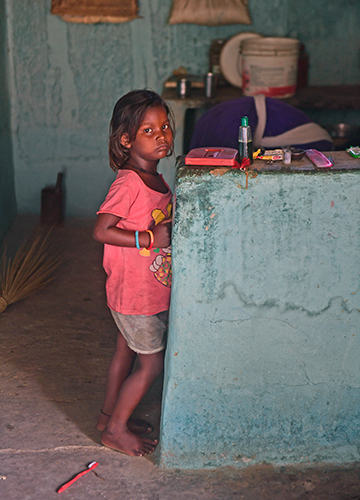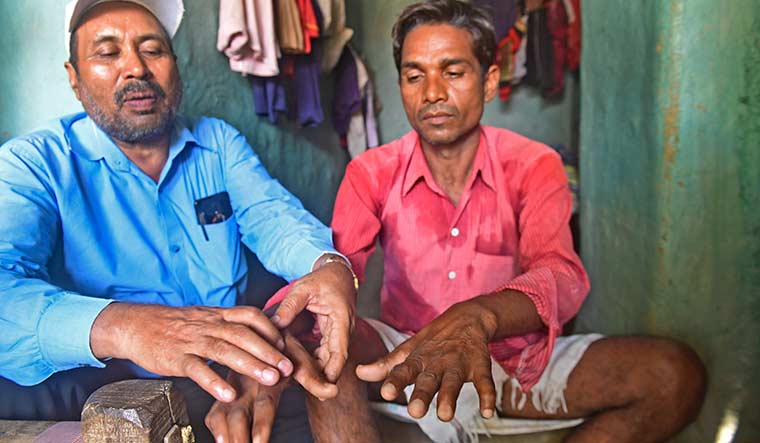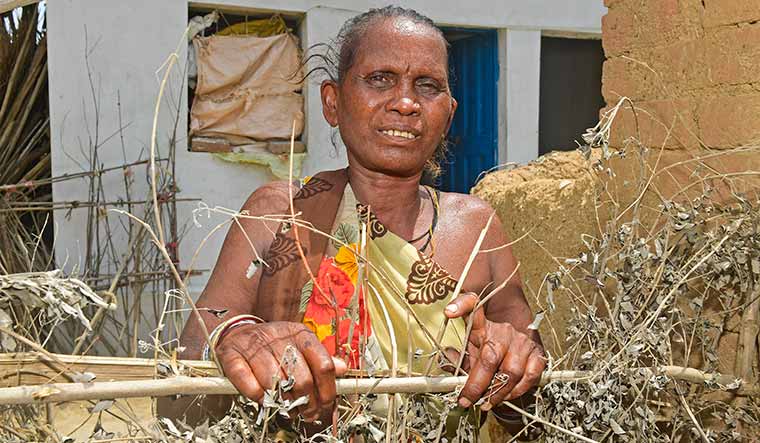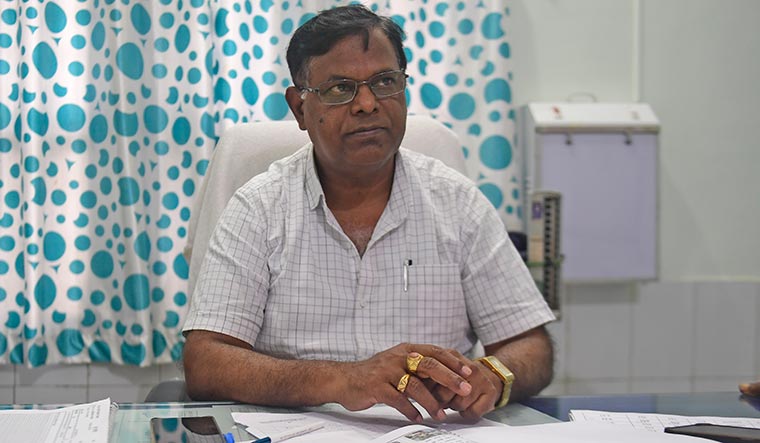Three years ago, Santoshi Kewat, then 28, from Salaunikhurd village, 250km from Raipur, noticed white patches on her arms and legs. Initially, she ignored them as they were painless and numb. But they grew larger and spread all over her body. Soon, she noticed similar lesions—lighter than skin colour and numb to pain, touch and temperature—on her 15-year-old sister Radha's hands and back. The sisters sensed something was wrong, but could not decide whether it merited attention. Within days, the lesions began to show on their six-year-old nephew Nirmal. That did it.
They went to Rajni Sahu, the village mitanin (female health volunteer) and a community health worker, who lived about 100m away. Sahu, who had been trained to identify symptomatic diseases, said that all three had kusht rog—leprosy.
They were immediately taken to the community health centre and were put on a year-long MDT (multi-drug therapy) to prevent further deformity. The family, “shocked and devastated” decided to keep it quiet. But their woes had only begun.
Four days after Santoshi, Radha and Nirmal were taken to the community health centre, Ganesh Devangan, the government appointed non-medical assistant (NMA) at the centre, examined the other members of the family. Eight of them—the parents, Narayan and Mirabai, three sisters of Santoshi and Radha, Sumitra (Nirmal's mother), Madhu and Sahodhra, and their brothers Kashi Ram, Komal and Chhote Lal—were identified with leprosy. The symptoms were skin lesions, formation of nodules on the ears, thickening of the brow ridge and discolouration of skin on their arms, limbs and torso. Sumitra's husband, Santosh, refused to get tested and went to some local jhaadu practitioner, according to Madhu. But, Madhav Deshpande, then state leprosy control programme officer, Chhattisgarh, said that Santosh was infected and that he had supervised medication for him. But NMA Devangan said Santosh had been “off limits”.
Two years after they were all put through MDT, with the possible exception of Santosh as per the NMA, leprosy continued to haunt the Kewats. In January 2019, Sahodhra's five-year-old daughter Garima was diagnosed with the disease. Her father Pooran Lal, also afflicted with leprosy, died in February because of illnesses related to alcoholism. And in April, Sahodhra was admitted to the far away government district hospital after developing a high grade reaction after she left her dose incomplete. Garima now lives with the Kewats.
“I was shocked to know that she (Garima) too became positive with MB (multibacillary) leprosy,” said Devangan. “The sisters, Radha and Madhu, informed me that they had noticed lesions on her body just as they had on their own. I am assuming that the little girl got the bacteria from her now deceased father Pooran Lal who had taken her with him to Jammu where he worked as a manual labourer.” Garima's diagnosis rattled the officials, right from the community health workers to the state health department, because infection in children is an indicator of active transmission and high prevalence of infection in the community. “It is a clear indicator that the level of transmission is high,” said Deshpande. “We are aware of it and working on it. But given the nature of the disease, it is almost impossible to know of its existence until the first symptoms are seen.”
As a precautionary measure, the WHO had approved a 600mg rifampicin tablet in September 2018. It is a potent anti-bacterial drug, to be given to those who are in close contact with recently diagnosed patients, including family members, neighbours, co-workers and, in the case of children, their classmates and teachers. It should not be given to pregnant women and children below the age of two. Although not foolproof, it helps contain transmission. Accordingly, Garima should have been given the prevention dose. “But we missed it,” said Deshpande. “She might have been saved from it otherwise.” Deshpande pops in a rifampicin tablet once in a couple of years, as a precaution. “Who knows when it might strike me unannounced,” he quipped.
Garima is currently undergoing treatment. The Kewats are below-poverty-line migrant labourers who also work in brick kilns and grow paddy once a year during the monsoons. Three of the four Kewat daughters studied till class 10. Komal, one of the three male children, has started class 11 at a nearby village. “We had the disease, but now we are cured. We want to lead a normal life,” said Madhu, looking at her siblings and smiling. She is next in line for marriage and wants the “drama around leprosy to end”.
An active surveillance drive followed the diagnosis of the Kewats, during which over 23 new and existing cases were detected from the village within a few months. “People from our village began sensing a sort of ostracisation from the neighbouring villages,” said Madhu. “They would not really interact with us anymore. Now after a gap, everything is coming back to normal and we want it to last.” Fortunately for them, none of the Kewats suffer from deformity resulting from undetected long-term leprosy. “We are trying to investigate but it is very difficult to assess the exact reasons why it happened in a single family,” said Sarwat Husain Naqvi, who works with The Leprosy Mission and is also a consultant with the National Leprosy Eradication Programme (NLEP). “There are predisposing factors and determinants which influence the spread of the disease.” Everyone in the family shares the same environment, is exposed to the same levels of sanitation and overcrowding, and their levels of nutrition is also the same as they are all eating the same food and so their immunity level is also alike. Because leprosy is a disease that strikes people with low immunity, the Kewats are more vulnerable because they lack enough nutrition to support higher immunity.
From 2016 to 2019, there have been 124 cases of children with leprosy in the district of Bhalodabazaar under which 225 villages, including Salaunikhurd fall. Bhalodabazaar is third in the list of high-endemic districts in Chhattisgarh, after Mahasamund and Rajgarh. The number of cases with grade-2 deformity, too, have been exceedingly high, albeit with a decline from 4.58 per cent in 2016-2017 to 3.29 per cent in 2018-2019. These two factors suggest an active rate of transmission in the area. High prevalence of deformity—clawed hands, anaesthetic toes with ulcers, skin lumps and bumps—also indicate instances of late detection.
“We agree that there is late detection to a certain extent but an average of four to six months of late detection is bound to be there in all cases given the nature of the disease. It is a disease which has a high incubation period from six months to 20 years during which a patient might not show any symptoms at all,” said Dr Firat Ram Nirala, block medical officer at Palari, about 100km from Raipur. “And then when they do appear, they begin as anesthetic patches which are painless and numb. Hence, patients do not end up coming for check-ups until they really experience some form of deformity.”
This is precisely why the government began active surveillance through the Leprosy Case Detection Campaign under the NLEP in 2016. The designated officials have to visit homes in every district and proactively examine people for symptoms of leprosy. The officials said that surveillance had started post 2016. However, on the ground, the situation is still the same, at least for some.
In early 2019, Santosh Khurre, a resident of Salaunikhurd who works in a pencil factory in Jammu, was asked to take a break when he found it difficult to hold things with his fingers. It was only after two fingers developed numbness and stiffness that he realised that he had leprosy and began taking medicines. “Had I been detected earlier, may be I would have been spared of this deformity (numb and clawed fingers) and my fingers would have been normal. I will now look for some other kind of work which I can do with these deformed hands,” said Khurre. He has been advised reconstructive surgery but has not been counselled enough to be able to do it. “I am afraid my hands might become worse than they are,” he said.
For most villagers, the nearest option to get themselves checked for the first symptoms of leprosy remains the primary health centre. However, a visit to the nearest centre in Bhatgaon, about 50km from Salaunikhurd, revealed that nobody would attend to patients afflicted by kusht rog. “We don't examine them here. Neither do we have the MDT tablets for them. We send them to the CHC (community health centre),” said the assistant medical officer (AMO) on duty, on the condition of anonymity. For a villager from Salaunikhurd to visit the nearest CHC, which is about 200km in Bhilaigarh block, it would take close to three hours one way. And the state transport buses ply only twice a day. The state, however, remained in denial. “The AMOs cannot deny treatment to a leprosy patient. They are bound by duty,” said Deshpande. Fifteen-year-old Kulbaruk Kunaar was barely able to move his fingers when he was diagnosed with MB leprosy. On June 16, 2019, he underwent a surgery at The Leprosy Mission Hospital, Chandkuri. “It has brought a fifth of the movement back,” he said. "Enough for me to hold light things and eat on my own. But had I known about it earlier, before it struck me, I could have had my normal fingers today.”
“There are gaps,” said Devangan. “I am the only one who is looking after these 20 to 30 villages. But I cannot come to the villages every day because I also need to sit in the block for patients who visit me. But when there are campaigns such as the focused leprosy campaign and LCDC, I along with mitanins and rural health officers visit the villagers from time to time to detect cases and help.”
From 2016 to 2019, 801 new leprosy cases came to light within the Bhailaigarh block alone in the district of Bhalodabazaar. The current prevalence rate—number of cases per 10,000 people—is 4.91, while in the entire state it is 1.99, which is still way above the national prevalence rate of 0.6. “The numbers are significantly high but that does not mean that leprosy is back,” said Deshpande. “It had never been eliminated in the first place, contrary to what the government maintained way back in 2005.”
Said Naqvi: “What they did was put the population of more than 1 billion in the denominator and the number of cases of leprosy in the numerator and the resulting rate will be less than the definition of the high-endemic country.” The so-called elimination of leprosy sent a wrong message among the workers, he said. “The whole system was disowned but the disease did not end,” said Naqvi. “So, post 2005 funding stopped and the staff, especially the NMAs who were efficient in recognising and treating leprosy, became a dying cadre. And the programme itself was combined with the other programmes.” Now, there are AMOs at the PHC who are supposed to look after leprosy patients, but they say that it still is the job of the NMAs, said Naqvi.
Kumari, Radha's friend and a leprosy patient who is now cured, complained about the dapzone tablets she had been taking which she said made her feel fatigued all day. “It is a big pain to take those tablets,” she said. “I know of so many in our village who have given up the treatment because they think that the medicine will make them dark and weak.” Devangan, who knows and is friendly with almost all the villagers, said that some of them do not take his advice seriously. “There's only so much I can do,” he said.
In an attempt to locate the index or source cases of transmission in the village, the experts pinned it down to a couple of residents. “First we thought it was Nonibai the septuagenarian,” said Devangan. “But just when we thought it was her, we found another one, older than her—the octogenarian man who does not even have fingers. He had gotten it about three decades back, but wrongly claims that he had medicine and was treated. We have put him on medicines again.” It was not easy to identify Nonibai as the other index case, said Devangan. “She does not have classical leprosy features nor any form of deformity and so it is very easy for her to transmit the infection to numerous others within a short time,” he said. “She looks young with a cherry blossom face colour.” These kind of patients have to be brought to the centre and a proper pathological investigation has to be done. “It is when we miss out on detecting patients like Nonibai that the transmission happens quick and the numbers increase,” said Devangan. “They are the time bombs in leprosy. And they will not be captured by the campaign.”
One of the villagers said that Devangan was the only person who visited them regularly—every four to five months. The NMA sits inside a dingy office which is filled with files—data on leprosy in the area under his charge. But his time serving the patients is coming to an end. The designation of NMA will soon be discontinued. He has already got a new set of visiting cards printed. They have his name as the founder of a business, along with his family members. “What to do? I also need to think about myself and my family,” said Devangan. “I cannot keep doing field visits often because it is too far and there is anyway no motivation. The officers are in their own offices and nobody wants to actually come down and visit the patients as often as they should.”





